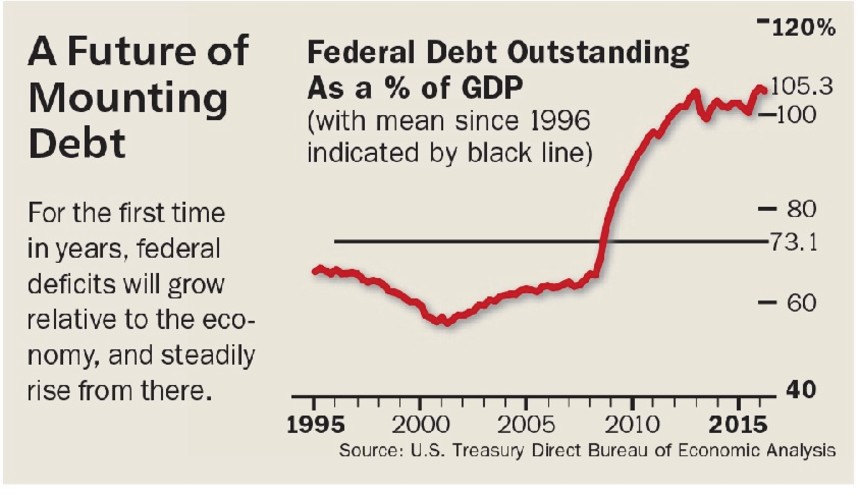David Ader’s “Economic Beat” column in Barron’s focuses on the latest bad news associated with the federal deficit.
In short, the federal budget deficit is about to explode.
Our interest was particularly drawn to the CBO’s view that, by 2026, the deficit, relative to gross domestic product, would be “considerably larger than its average over the last 50 years.” For historical context, federal debt held by the public will edge to 77% of GDP in 2016—the most since 1950.
THIS IS A PROBLEM. It’s obvious that debts eventually must be paid. We can fret over how that will be accomplished, given the new normal of subdued economic growth (real GDP expansion averaged 3.2% from 1970 to 2000, 1.8% from 2000 to 2016, and 1.4% since 2006) and an aging population that expects to be supported in its grossly underfunded retirement.
That isn’t the only concern and may not be the biggest. The problem is that government debt is simply bad for growth.

Lacy Hunt, an economist at bond manager Hoisington Investment Management in Austin, Texas, has done a lot of work in this area. He points out that government spending has at best a trivial, if not slightly negative, multiplier. That means that for every dollar of federal spending there’s a contraction in private GDP. (Hunt cites many academic studies, including a recent paper from the St. Louis Federal Reserve, “Government Spending May Not Create Jobs Even During Recessions.”) Of course, government spending can boost growth for a while, but we’re talking about a protracted period of increased deficits. Indeed, the debt-to-GDP ratio has been over 90% since 2010 (see chart, above). Japan’s similar measure hit 100% in 1997 and runs about 225% today. Few will argue that this has fostered strong domestic growth in Japan.
Hunt’s estimates put the multiplier at minus 0.01%, a figure likely to become more negative as mandatory spending—think entitlements—gains over discretionary spending. Mandatory spending today amounts to nearly 70% of federal spending, a record, and is rising. The problem is that these programs provide income for much of our population, but skew our borrowing priorities. In essence, we’re borrowing for consumption today, rather than for long-term investments to generate future income. Hunt’s point is clear; taking on this kind of debt eventually will cause bankruptcy.


